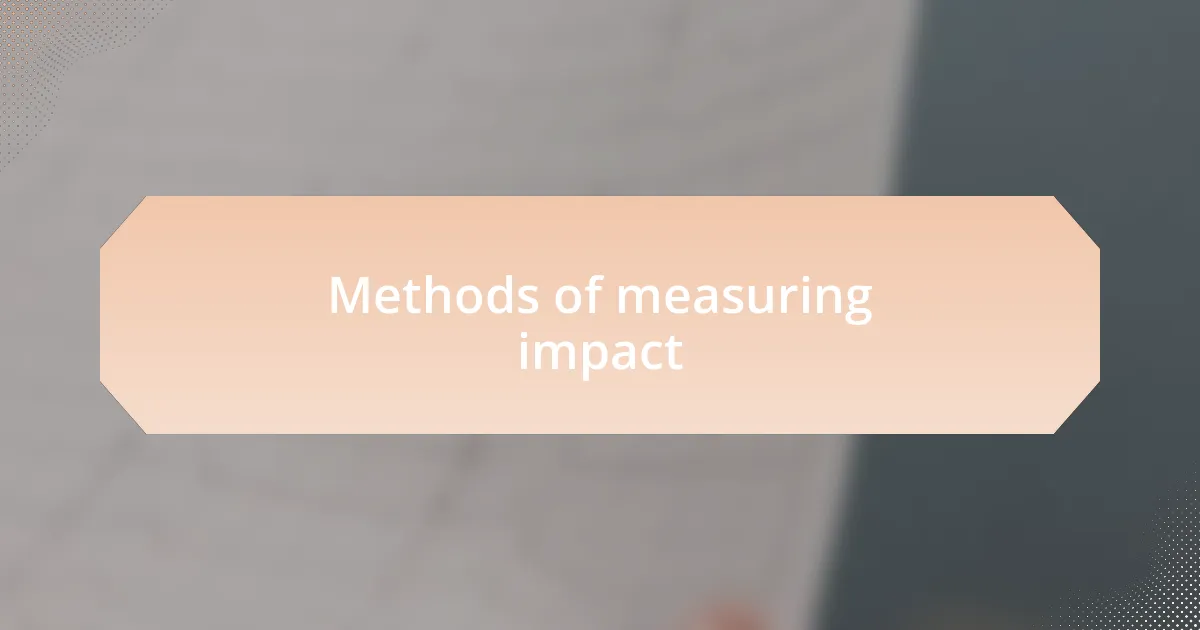Key takeaways:
- Impact measurement in volunteering encompasses both quantitative metrics and qualitative personal stories, highlighting the significance of human connection.
- Volunteering in ministry fosters personal growth and community bonds, demonstrating how service can transform individual lives and collective experiences.
- Hospital ministry addresses spiritual needs and provides emotional support, showing the importance of integrating faith with healthcare to enhance patient care.
- Effective evaluation of volunteering efforts should combine qualitative feedback with traditional metrics and include ongoing reflection to adapt to community needs.

Understanding impact measurement
Impact measurement in volunteering allows us to assess the effectiveness of our efforts and understand the tangible differences we make. For example, when I participated in a local hospital ministry outreach, we tracked not only the number of patients served but also their feedback on emotional support. It became clear that measuring impact goes beyond just numbers; it captures stories of hope and healing.
Have you ever wondered how we can truly gauge the effectiveness of our volunteering efforts? I remember when a fellow volunteer shared how a simple visit brought immense joy to a lonely patient. That personal connection is hard to quantify, yet it highlights the profound impact we have. This is why qualitative data, like personal stories and testimonials, is vital in understanding the real change we facilitate.
Moreover, embracing impact measurement can lead to valuable insights for future initiatives. After analyzing our outreach program, it became evident that certain approaches resonated more deeply with patients than others. This realization prompted us to adjust our strategies, ultimately enhancing our ability to provide support. Isn’t it fascinating how a structured approach can improve not just our volunteering experiences, but also the lives we touch?

Importance of volunteering in ministry
Volunteering in ministry serves as an essential bridge between faith and compassionate action. I recall a time when our church organized a food drive for families in need. The gratitude expressed by recipients was overwhelming, reminding me that even small acts can significantly uplift those who are struggling. It reinforced for me that volunteering isn’t merely about giving; it’s about connecting with and uplifting our community through our faith.
Another key aspect of volunteering in ministry is the personal growth volunteers experience. I remember feeling uncertain about my ability to lead a prayer group, but through the experience, I found my voice and gained confidence. This growth not only benefited me but also encouraged others to engage more deeply in their spirituality. Have you considered how stepping up in ministry could transform your own path, or how your willingness to serve could inspire someone else?
Ultimately, volunteering fosters a sense of belonging among both volunteers and those they serve. It creates a community rooted in shared values and support. I’ve seen firsthand how friendships blossom in the context of service; I’ve forged lasting relationships with fellow volunteers through shared experiences that have enriched my life. Isn’t it remarkable how stepping outside of ourselves can create such strong bonds and a vital sense of purpose?

Overview of hospital ministry
Hospital ministry is a unique branch of service that addresses the often-overlooked spiritual needs of patients, families, and medical staff within healthcare settings. I’ve witnessed the profound impact that compassionate presence can have. For instance, during my time volunteering in a hospital chapel, I saw patients light up at the simple act of a listening ear; it made me realize just how vital emotional support is in a clinical environment.
In these moments, ministry goes beyond mere spiritual guidance; it becomes a source of hope and comfort during challenging times. One evening, I sat with a family who had just received distressing news about their loved one. As we shared our fears and prayers, I felt an overwhelming sense of connection that transcended the clinical atmosphere. Isn’t it heartening to think that, amid the sterile walls of a hospital, human kindness can flourish?
Moreover, hospital ministry cultivates an environment where faith can thrive even in the darkest moments. I’ve observed how chaplains work collaboratively with medical professionals, creating a holistic care approach that encompasses physical, emotional, and spiritual dimensions. It’s fascinating to see how integrating faith into healthcare can not only offer solace but also reinforce resilience for both patients and caregivers. Have you considered how impactful such ministry can be in serving those experiencing vulnerability?

Methods of measuring impact
Measuring the impact of volunteering in hospital ministry can be accomplished through various methods, each offering unique insights. One effective approach is using surveys to gauge the emotional and spiritual well-being of patients and their families before and after interactions with chaplains. In my experience, I’ve seen how individuals respond to simple questions about comfort or hope, revealing profound changes in their outlook.
Another method involves assessing the overall atmosphere of care within the hospital. By observing interactions between healthcare workers and chaplains, I’ve noticed a tangible shift in team dynamics, especially when emotional support is actively integrated into the patient care process. Isn’t it remarkable how the presence of a ministry volunteer can uplift not just patients but also the entire medical staff?
Furthermore, case studies are invaluable for illustrating specific instances where hospital ministry has made a significant difference. I recall a story of a patient who, after engaging with a chaplain, found renewed strength to face her treatment. Documenting such transformations helps emphasize the deeper, often unmeasured effects of ministry work, inviting others to reflect on the true value of their contributions.

Challenges in impact measurement
Measuring impact in volunteering faces significant challenges, especially in a hospital ministry context. One major issue is the subjective nature of emotional and spiritual well-being. How do we quantify feelings like hope or comfort? I’ve often thought about this during my time volunteering. Despite positive feedback from families, translating those emotions into measurable data feels nearly impossible.
Another obstacle is the variability in individual experiences. Each patient’s journey is unique, and what resonates with one might not affect another at all. I remember a time when a chaplain’s visit profoundly impacted one patient, while another seemed untouched. This disparity makes it tricky to draw broad conclusions about the ministry’s overall effectiveness. How do we reconcile these differences to create an accurate picture?
Finally, there’s the issue of time constraints. Gathering meaningful data often requires lengthy engagement and follow-ups, which can be difficult in a busy hospital environment. Most volunteers I know are deeply committed, but they often juggle multiple responsibilities. When reflecting on my own experiences, I found that sometimes, the most profound impact happened in fleeting moments, yet capturing those moments for measurement purposes requires deliberate effort. How can we ensure that those invaluable interactions are not lost in the process?

Personal reflections on impact
One poignant moment that sticks with me occurred during a late-night visit to a pediatric ward. A young boy, clearly scared and in pain, just needed someone to sit with him. I held his hand and shared stories of superheroes, and for a brief time, I saw the fear fade from his eyes. That experience made me realize that impact is often measured in those intangible moments of connection rather than in statistics or reports. How do we convey the power of that simple human interaction in our measurement strategies?
Reflecting on the diverse paths of healing I’ve witnessed, I find it fascinating how each interaction shapes a person’s experience. For some, a shared prayer may bring solace, while for others, it might feel hollow. One time, I spoke with a family who found comfort in a brief visit, even as another family expressed frustration about a lack of visible change. It left me wondering: How can we capture the varying degrees of impact across such different experiences? It challenges the way we think about success in our ministry.
What really strikes me is the time we often overlook in our impact assessments. In my own volunteering, I’ve had several short encounters that felt fleeting yet profoundly moving. I remember a single exchange with a grieving family; they simply needed to express their fears aloud. In that moment, I felt I was part of their healing journey. It leads me to ponder: Are we prioritizing metrics over meaningful interactions? If so, we might be missing out on the heart of what our ministry truly accomplishes.

Recommendations for effective evaluation
When it comes to effective evaluation in volunteering, it’s crucial to incorporate qualitative feedback alongside quantitative data. I recall a time when our team gathered stories from volunteers about their experiences, and the soft-spoken accounts of gratitude we received were as impactful as any metrics we could measure. How can we blend these personal narratives with traditional assessments to capture the full spectrum of impact?
Another approach I’ve found useful is engaging directly with the communities we serve. During one of our outreach days, I spent time talking with individuals who had benefited from our support. Their insights revealed what truly mattered to them, far beyond what our initial surveys indicated. Isn’t it fascinating that simply listening can uncover aspects of our work that we might otherwise overlook?
Finally, I genuinely believe in the importance of ongoing reflection and adaptation. In my experience, after we implement a project, taking the time to revisit and discuss its outcomes as a team allows us to grow. Have we thought enough about how our evaluations can evolve alongside our ministry? Emphasizing this can ensure we remain responsive to both the needs of the communities we serve and the effectiveness of our efforts.